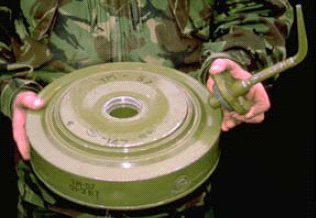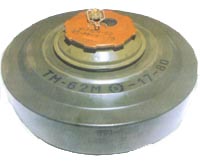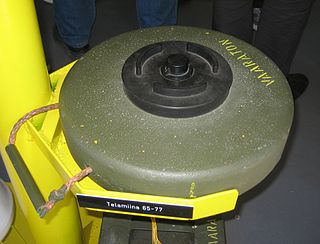Related Research Articles

The Type 11 70 mm infantry mortar, was a muzzle-loading, rifled bore infantry mortar used by the Japanese. The Type 11 designation was given to this gun as it was accepted in the 11th year of Emperor Taishō's reign (1922). It was first used in 1922 and was the first mortar to be introduced by the Imperial Japanese Army. The mortar was later replaced by the Type 92 battalion gun.

The Tellermine 42 (T.Mi.42) was a German metal-cased anti-tank blast mine used during the Second World War. The mine was a development of the Tellermine 35 with improved resistance to blast. It was followed by the simplified Tellermine 43.

The Tellermine 43 was a German circular steel cased anti-tank blast mine used during the Second World War. It was a simplified version of the Tellermine 42, which enabled simpler production techniques. Between March 1943 and the end of World War II, over 3.6 million Tellermine 43s were produced by Germany. Copies of the mine were produced by several countries including Denmark (M/47), France and Yugoslavia (TMM-1).

The TM-57 mine is a large, circular Soviet metal-cased blast anti-tank mine. It can either be triggered by a pressure or a tilt-rod fuze. A development of the TM-46 mine, it is found in Africa, the Middle East, and South East Asia.

The TM-46 mine is a large, circular, metal-cased Soviet anti-tank mine. It uses either a pressure fuze or tilt-rod, which is screwed into the top. Anti-tank mines with this type of fuze were capable of inflicting much more damage to armored vehicles. The TMN-46 is a variant of the mine fitted with a secondary fuze well on the bottom which is slightly off-set from the centre of the mine. This secondary fuze well can be fitted with a pull-fuze which functions as an anti-handling device. The mine was used by the North Vietnamese forces during the Vietnam War, and is found in many countries in Africa, the Middle East and South East Asia.
The PMN series of blast anti-personnel mines were designed and manufactured in the Soviet Union. They are one of the most widely used and commonly found devices during demining operations. They are sometimes nicknamed "black widow" because of their dark casings.
The TMD-44 and TMD-B are simple rectangular Soviet wooden box cased anti-tank blast mines, they were both used during the Second World War. Both mines are similar in design, differing only in fuzing mechanism. The wooden construction of both the mines makes them unpredictable as rot and insects can eat away the wooden case, reducing activation pressure to as little as 3 kg. Both mines are found in a number of countries including Afghanistan, Angola, Chad, Cuba, Egypt, Korea, Mozambique, Namibia, Rwanda, Yemen, Zambia, and Zimbabwe.
The PT Mi-K is a Czechoslovakian metal-cased anti-tank blast landmine. The mine uses a metal grid instead a pressure plate, this gives it resistance to overpressure. The mine is no longer produced, but is found in Afghanistan, Cambodia, Eritrea, Namibia, Nicaragua and the Western Sahara.
The M7 is a small, metal-cased United States anti-tank blast mine that was used during the Second World War. It was based on the British Hawkins grenade. Approximately 2.5 million were produced before production ceased, and although it has long since been withdrawn from U.S. service, it can be found in Angola, Burma, Cambodia, Chad, Eritrea, Ethiopia, Korea, Lebanon, Myanmar, Somalia, Thailand, and Zambia.

TM-62 is the designation for a series of Soviet anti-tank blast mines. The mines have a central fuze and typically have a 7.5 kilograms (17 lb) explosive charge, however they vary greatly in detail. The mines can be laid manually or automatically from a mine laying machine including the PMR-1, PMR-2 wheeled towed mine layers, the GMZ tracked mine laying vehicle and the VMR-2 helicopter mine laying system.
The SB-81 is an Italian plastic cased minimum metal anti-tank blast mine dating from the early 1980s. The mine uses an air pressure based fuze, which gives it protection against overpressure and blast. It can therefore be regarded as a blast resistant mine. The mine can be scattered by hand or by mine laying systems.

The Riegel mine 43 or is a German steel cased anti-tank bar mine used during the Second World War. The mine is a long thin rectangle. It consists of a lower and upper metal tray, and an internal metal-cased explosive block. It uses two ZZ42 fuzes inserted into either end of the internal block, although it can be used with an additional pressure fuze on the top. The mine is similar to the Italian B-2 mine. A variant, the Riegel mine 44 was also produced with a different fuze. Approximately 3,051,400 were produced between 1943 and 1945.

The Type 72 is a Chinese metal-cased circular anti-tank blast mine, it is similar to the Russian TM-46 mine, a plastic cased version of the mine is also produced, the Type 72 non-metallic anti-tank mine. The mine has a central plastic cased blast resistant fuze.
The MAT-62B is a Romanian plastic cased circular anti-tank blast mine. It is very similar to the Russian TM-62P2. The mine has a central fuze well which accepts the bakelite P-62 pressure fuze, which contains a CD-11R detonator. The mine can accept fuzes from the Russian TM-62 and TM-72 series of landmines. The low metal content of the mine makes it difficult to detect. A caseless version of the mine, the MAT-76 mine is also produced.
The MAT-76 is a large circular Romanian minimum metal anti-tank blast mine. It is similar to the MAT-62B mine, sharing a fuze. The mine is actually a cast block of TNT with a thin coating of fibreglass. The mine has a central fuze well that normally uses a P-62 pressure fuze, although it can be used with any of the fuzes designed for the Russian TM-62 and TM-72 series of mines. The bakelite plastic used in the fuze of a MAT-76 may become brittle in desert conditions, which can reduce the activation pressure. This may make the mine unstable i.e. can detonate simply by handling it. The mine is found in Angola, Iraq, Kuwait, Liberia, Mozambique, and Zambia.
The No 6 mine is an Israeli metal-cased anti-tank blast mine. It is a direct copy of the Russian TM-46 mine, the only notable difference being the filling cap, which is domed on the TM-46 and flat on the No 6. It can be fitted with the No 61 pressure fuze or a No 62A tilt rod fuze. The mine is found in the Falkland Islands, Israel, Lebanon and Oman.

The TM 65 is a circular Finnish minimum metal anti-tank blast mine. It is broadly based on the Russian TM-62 mine. The mines body is made from a thin shell of fibreglass over a cast block of explosive, with a central fuze well that holds the pressure fuze. The original TM 65 used a US-65 fuze as used in the SM-65 anti-personnel mine, the later TM 65 77 uses a pressure fuze similar to the Russian MV-5 fuze called Painesytytin 77.
The MKT Mod 72 is an Albanian circular, metal-cased anti-tank blast mine, a copy of the Russian TM-46. Two versions of the mine are produced, the PX designated version of the mine is fitted with a secondary fuze well in the base of the mine that accepts an MUV type anti-lifting device. The mine uses a mechanical pressure fuze similar to the Russian MV-5.

The ATM-72 is a steel cased circular North Korean anti-tank mine. It is similar to the Russian TM-46, with a thick wire carrying handle and a filling plug. The mine uses a four pronged fuze, downward pressure on any of the levers will trigger the mine. The lever action of the mine makes it resistant to overpressure and blast.
The TM-44 was a circular metal-cased Soviet anti-tank landmine used during the Second World War. The mine's case consisted of a short cylinder with the entire top surface being used as a pressure plate. The mine was normally painted olive drab and was broadly similar to the earlier, smaller, TM-41 mine.
References
- Jane's Mines and Mine Clearance 2005-2006